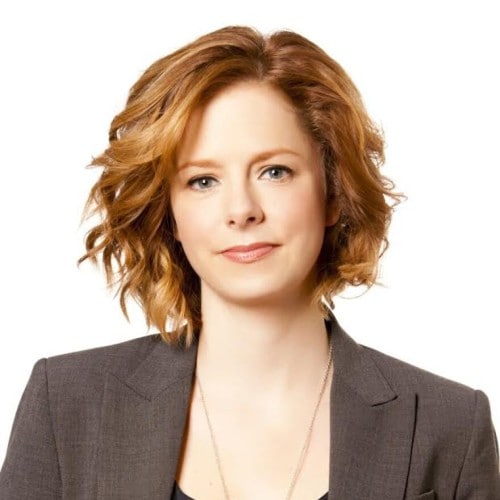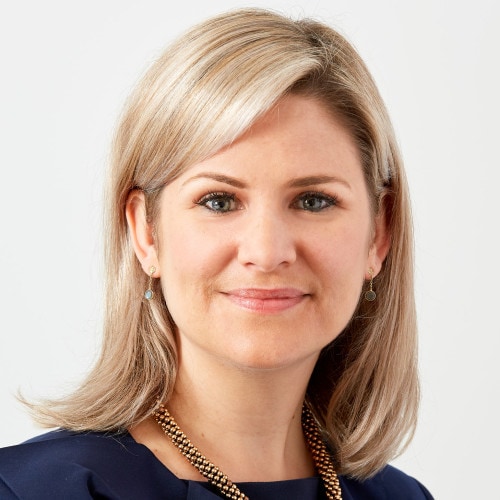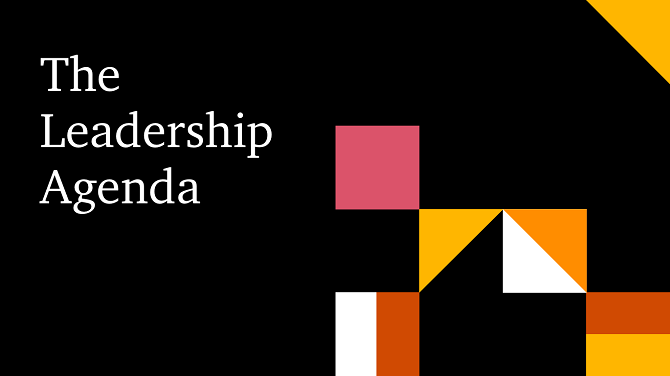{{item.title}}
{{item.text}}

{{item.text}}
Take on Tomorrow, the award-winning podcast from our management publication strategy+business, brings you Episode 3: “How can business prepare for the next disaster?”
Cyberattacks, supply chain disruptions, hurricanes, and pandemics: the list of things that can go wrong for a company is long, and it is growing. So, how can business prepare for the unknown? In this episode, we’ll hear how businesses can help society and organizations be better prepared, before the next disaster strikes.
Lizzie O’Leary
Podcaster and journalist
Ayesha Hazarika
Columnist and former senior political advisor
Craig Fugate
Former Administrator
US Federal Emergency Management Agency (FEMA)
Bobbie Ramsden-Knowles
Crisis and Resilience Partner, PwC UK
2023 Shorty award winner for "Best Branded Podcast" series
2023 Webby award nominee for "Best Podcast" series
{{item.text}}

{{item.text}}
As reinvention pressure rises, CEOs need to rewire their decision-making.
Sharp, actionable insights curated to help global leaders build trust and deliver sustained outcomes. Explore our latest content on the global issues affecting organisations today from ESG to value creation, technology and cyber to workforce transformation.
Bobbie Ramsden-Knowles: Over the years, I’ve done many crisis exercises with executives, and you sometimes get challenged on this: “It will never happen.” And I think, you know, unfortunately, what we’ve seen is, as I say, those severe scenarios can happen now.
Craig Fugate: This tendency, that everybody thinks in disaster movies that, uh, you’d have this, you know, action figure like Tommy Lee Jones in Volcano, where one person has all the answers and makes all the decisions—it turned out that actually slows down and gums things up.
Bobbie: And in crisis, the one thing crisis rooms always have is a lot of food—always a lot of sugar, I found.
Ayesha Hazarika: Absolutely—having worked in a lot of political crises, I agree. And lots of late-night pizza.
Lizzie O’Leary: From PwC’s management publication strategy and business, this is Take on Tomorrow, the podcast that brings together experts from around the globe to figure out what business could and should be doing to tackle some of the biggest issues facing the world. I’m Lizzie O’Leary, a journalist in New York.
Ayesha: And I’m Ayesha Hazarika, a columnist and, in a former life, a senior political advisor in London. In this episode, we’re talking about disasters and how to prepare for them, even though most often you don’t know what you’re preparing for.
Lizzie: We talked to Craig Fugate, the man who fixed the US government’s emergency response after its mishandling of Hurricane Katrina in 2005.
Ayesha: And who came up with an ingenious way of measuring damage from a big storm by seeing if he could get a waffle at an American diner.
Craig: If there was anything going to be open during or after a storm, it was going to be a Waffle House. And since there were so many of them, it became an effective tool.
Lizzie: Fugate is the former head of the Federal Emergency Management Agency, FEMA. And he talks about the right way to deal with disasters, what businesses can do to help, and the threats of climate change that we’re not talking about enough. That conversation is coming up shortly.
Ayesha: But first, today, we’re also joined by Bobbie Ramsden-Knowles. Bobbie is a crisis and resilience partner with PwC UK. And Bobbie, you are here to talk about disasters. Always fun.
Bobbie: It is indeed. Thank you for having me.
Lizzie: I’m so interested to talk to you, because I have covered many disasters in my career: the aftermath of Katrina, the BP oil spill, Hurricane Maria in Puerto Rico. And I’m really curious to hear your expertise. Bobbie, I wonder if you could tell us a little bit about some of the situations you’ve handled and how you walk into a crisis situation and begin talking to corporate leaders.
Bobbie: I’ve worked on a real variety of different types of crises over the years, ranging from industrial relations action to offshore gas leaks, product recalls, manufacturing incidents. My job often is to go in and work with the crisis leader to help them take that step back and to really consider: what are the issues they’re facing? How is this going to play out over the longer term? And how can they best prepare themself and the organization to respond to it?
Ayesha: And, obviously, you go in and help a lot of organizations when a bad thing happens. But how can you help advise or get your business or client to understand about trying to look ahead and foresee and plan for disasters?
Bobbie: I think it’s really interesting, because, if I think, over the years, pandemic has been on the risk register; geopolitical tension has been there. And they’re not necessarily the scenarios we’ve planned for or exercised. A few years ago, we might not have felt they are plausible, but what we’re seeing now is those high-impact events are absolutely plausible.
Ayesha: Take nothing off the table. Think of the worst thing that could happen. Because it could happen, right?
Bobbie: Exactly. Over the years, I’ve done many crisis exercises with executives, and you sometimes get challenged on this: “It will never happen.” And I think, you know, unfortunately, what we’ve seen is, as I say, those severe scenarios can happen now. I think one of the big mistakes sometimes organizations make is thinking that actually having a crisis plan is it. “As long as we’ve got the plan, we’re good.”
But it’s people who manage crises. It’s not the documents. Documents are great, and they are absolutely necessary. But for me, one of the biggest lessons out of COVID-19 was that people managed crises. And we need to invest as much in their leadership and how you respond to the pressures as we do in writing the plans.
Lizzie: I have a question about the people component of this, because I think this is something that we have seen very much over the past two years. People are exhausted. Their nerves are frayed. They snap, they’re tired. They need extra support. How is that something you present to an executive or an HR team and say, "Look, you’re going to have to prop your people up"?
Bobbie: Yeah, absolutely. And I think it comes back to doing reviews on the back of COVID-19, to look at what worked well and actually what could be improved. And I think one of the common lessons was people adapted well and responded well, actually. But it’s operating in those crisis structures and teams for a long period of time which really put pressure on people.
And, also, coupled with that, having to work in new ways and…family pressures. When we talk to executives and HR teams, it’s about personal resilience. How do you help people who are responsible for leading in a crisis build their own personal resilience?
One of the really interesting things I’ve always thought is that in a crisis, actually, people often don’t want to leave. They want to do well for the company, for those who are impacted. But one of the best things you can do is make sure that you’re giving people a break in order to recover. That recovery is even more important when you’re operating under pressure.
We run a lot of training with crisis leaders specifically to help them think through how do they react under pressure. How does their behavior change? And how visible is that behavior? When I’m under pressure, it’s very obvious, my behavior changes. And that’s very clear. Whereas you get some people who, you can’t see the stress, you can’t see the pressure. And, actually, it’s very difficult to manage and lead those people, because you can’t adapt your style to manage that.
Lizzie: The people who shove it all down inside.
Bobbie: Yeah, and actually they’re amazing, because you never see the stress, so you think they’re totally fine.
Ayesha: See, I’d be really good in a situation like that because I’d just start panic-eating. That would be a clear indicator. That’s why I would be a very, very…
Bobbie: And in crisis, the one thing crisis rooms always have is a lot of food—always a lot of sugar, I found.
Ayesha: Having worked in a lot of political crises, I agree. And lots of late-night pizza.
Well, Bobbie, we’re going to come back to you and talk some more in a minute. But first, Lizzie, we’re going to hear the fascinating interview that you’ve done with Craig Fugate.
Lizzie: Yes. So Craig Fugate was the head of the Federal Emergency Management Agency, FEMA, during the Obama Administration. And FEMA’s primary mission is to support people and first responders on the ground before, during, and in the aftermath of disasters. Craig’s term began four years after Hurricane Katrina hit in 2005.
I covered the aftermath of Hurricane Katrina. I spent a lot of time there in the months and years after the disaster. And I can tell you that pretty much anyone in Louisiana will say that FEMA’s response to Katrina was woefully inadequate. So when Craig took over in 2009, he had a lot to figure out. What do you do with an organization reputationally that has lost the trust of the public? Before he ran FEMA, he was in charge of a state version, Florida’s Emergency Management Agency.
Ayesha: So that’s the sort of state version of FEMA?
Lizzie: Exactly. He was an emergency management professional and one of the things he had come up with is what I think is famous in disaster response circles, and nerdy circles, is something called the Waffle House Index.
Ayesha: What is a waffle house? It sounds like my kind of place!
Lizzie: A Waffle House, for those of you who are not familiar, is a big thing in the American South—is basically a breakfast restaurant. Though you can eat your waffles and pancakes and eggs at any time of the day. And it is also known as a place that gets open really quickly after a disaster. I’m going to let Craig describe how he invented the Waffle House Index.
Craig: Well, the Waffle House Index came out of the 2004 hurricane season. The first storm we got hit with that year was Hurricane Charlie, which was a category four hurricane. That was not very large, but where it hit was just very concentrated damage across the state. We were basically putting in 16-, 18-hour days. So breakfast was about the only meal you knew you could get. And it was nice to have a hot meal and a cup of coffee before you start out your day; and we’d start early, at five o’clock. And so, the first thing we found open was a Waffle House—went in and got breakfast.
And if you’ve ever been to a Waffle House, they have these big, bright laminated menus, with all this food on there. And we go to sit down, and the waitress hands us a piece of paper that was mimeographed, and we said, “What’s this?” She said, “Well, we lost power, so we had to throw everything out of the freezer. So all we’ve got is what’s on here.” And so, we ate breakfast and got our coffee and took off and ran our day.
One of the things we were trying to do is get faster response. And throughout my career, I was always taught that, you know, locals get hit, they assess, they determine what they need, they make the request to the state. And we’re always told, basically: be prepared for the first 72 hours to handle it by yourselves. And I said, “Why?”
Well, it turns out, by the time you assess, it takes about 72 hours before you can start moving stuff. I thought, well, if we know a bad hurricane hit, why don’t we just go? “Well, we don’t know what they need.” This is Florida, we’ve been through enough hurricanes. We can pretty well figure it out.
But then that raises another question. Hurricanes generally don’t have really sharp borders, like a tornado. You’d be driving, and you start seeing damages—trees down, billboards down. So where do you stop? As we were driving out, the story was, if you get there and a Waffle House is open and has a full menu, then it isn’t that bad, keep going. If the Waffle House is open and has a limited menu, it’s probably got more to do with mass care issues. Perhaps it has no power, maybe no water. But it’s not really where the search and rescue teams need to go to work. But if a Waffle House is closed because of the storm, start going to work, because you’re in the heavy-hit area.
So, two of the guys I was working with, a major in the Florida national guard, Tad Warfel, and our state meteorologist, Ben Nelson, we were doing slides. We had a bunch of counties hit, and we were just using a stoplight—red, yellow, and green—to indicate, you know, power outages, water outages, search and rescue. And each county was either red, yellow, or green that was showing our progress.
And they put a slide in there, and it was, if the Waffle House was closed because of the disaster, that was red. If the Waffle House was open, but it had a limited menu, it was yellow. And if the Waffle House was open and had a full menu, it was green. That’s the Waffle House Index.
I think the biggest observation I came away with was, we were doing what I call government-centric problem-solving. We always thought about what government was going to do, and we weren’t really thinking about the private sector. And in a lot of cases, I found out the private sector is already doing stuff, and we need to pay attention to them.
Lizzie: So, I want to actually dig into some of the private sector–public sector stuff in a little bit. But first, I want to ask you about FEMA, because you took over in 2009, and I think it’s fair to say that FEMA had had some pretty bad years before that. How do you come into an agency, an organization, that has been through something like that and failed a lot of people, and turn it around? What do you say to the people?
Craig: Well, I just said we’re going to do our jobs. Quit worrying about what people are thinking. And we’re not going to do PR to try to fix our image. I would always tell people, “Look, I’m not going to say FEMA is better. We’re going to do our job. If anybody can tell you we’re better, it’s going to be the people we’re serving and the government we’re helping.”
Lizzie: And what did that involve? Bit by bit, what are the things that a government can do right in the immediate aftermath of a disaster? What did they do wrong?
Craig: Well, we can speed up. And this came out after Hurricane Katrina. Congress had the hearings, they did the report, they passed some updates to the legislation. One of the things they clarified was that FEMA did not have to wait for a formal request from a governor to start responding.
This was always what the key thing was: until a governor asked and the President approved, those disaster funds, in many cases, people felt they couldn’t use them. I remember a lot of pushback from folks saying, “Well, you know, we’re going to have the IG come in here and say we’re being wasteful.” And I’m like, yeah, I’m not going to worry about the IG. “Well, there’s going to be hearings.”
I said, “Hearings are binary. If it’s a bad disaster, there’s going to be hearings, no matter what. So there’s two hearings you’re going to walk into. One: you didn’t send enough stuff fast enough, and you are going to get fired. Or the hearing where you sent too much stuff and spent too much money, and nobody suffered because of that.” I said, “This isn’t retail. The likelihood that we’re going to be precise is not very high.” You just have to be close. And the bigger the event, the more you need to bring.
Lizzie: So, I’m listening to you, and it makes so much sense when you’re thinking about a government agency. But let’s say you run a company. You’re listening to this conversation right now, and there’s a similar tension. If I’m Walmart and I’m able to pre-position my trucks to where I see there’s a potential cone of uncertainty around a hurricane, that makes a lot of sense. On the other hand, that’s a big outlay of money. I might get in trouble with my shareholders. Or investors could be mad at me. How should executives think about this? How should they be kind of trying to plan around an incipient disaster?
Craig: Well, they actually told me the answer. Because I was asking, “What’s in it for you?” Because it’s always return on investment. They said, “We don’t want to be the store that’s closed when our competitor’s open.” And there was actually an arms race.
I saw this in Florida in the beginning of 2004 when power was out. Usually, all the grocery stores would be closed. Drugstores would be closed. By the end of the 2004 hurricane season, they were getting generators in, they were setting up in their parking lots. You were getting portable drugstores that were in RVs that would pull up with their satellites and start doing prescriptions.
And this is what the grocery folks told me. They said, “Do you know how much it costs us to get a customer to come shop at our store on a regular basis?” Most people shop by pattern and habit. You go to the same grocery store. But if your store’s closed and there are competitors open, and you go there, once you start shopping there, it’s not likely you’re going to go back to your original store. And so it was interesting listening to them. They had learned that if they’re not open and serving their community, and their competitors are, they’re losing market share.
Lizzie: Well, let’s talk a little bit about climate change. How much should CEOs be folding climate-related planning into how they think about the next two years, five years, ten years?
Craig: Well, the most immediate thing to understand is that climate has already changed. This is not something that’s ten years down the road. And while a lot of emphasis at the investor and CEO level has been about reducing greenhouse gases, there’s been enough change that what we’re seeing now is most companies have not looked at adapting to the changed environment they’re in. But the question is, how does the change impact your bottom line?
Lizzie: We talk about climate change as an international, global phenomenon. It’s the climate, and yet, communities experience it differently. As we know from history, lower income, often minority and marginalized communities, are hit the hardest. I wonder if there’s a way to get local communities to interface with the national challenge and a way to make things a little more equitable.
Craig: What you describe is what I call the resiliency divide. Historically, FEMA has provided mitigation dollars, usually after disasters, but Congress, after the 2017 hurricane season, gave FEMA a lot more authority to spend money before disaster on reducing the impact or on what we call mitigation. They created a program called BRIC: building resilient infrastructure and communities.
And the current administration has increased that to, in the last infrastructure bill, to over a billion dollars. That’s real money. The problem is, historically, we’ve put so much emphasis on risk avoidance, measured in dollars. And this is a classic thing in the emergency management circles, that, for every dollar we invest in mitigation, we’ll save anywhere from four to nine dollars in cost. Unintentionally, this started creating a resiliency divide, where communities that had the grants management staff and the ability to apply for managed grants did best. And the properties they tended to invest in were the higher value ones. Because if I got a project with $100,000 to spend on an affordable housing section or on a lakefront with expensive homes, I’ll save more money with the lakefront homes because they were much more valuable.
And so the bias was driving mitigation towards the more affluent parts of the community, the more affluent properties, and in many cases, the population that probably had the financial resources to weather a disaster better, at the expense of the most vulnerable.
So, FEMA is now trying to move away from just a numerical value of dollars of risk avoidance and really look at the impacts to the community, to people.
Lizzie: Craig Fugate, thank you so much for a thoughtful interview and conversation.
Craig: My pleasure.
Ayesha: So that was Craig Fugate talking to my cohost, Lizzie O’Leary. And we’re joined again now by Bobbie Ramsden-Knowles, a crisis and resilience partner with PwC UK. And Bobbie, one of the things I was really struck by from Craig’s interview was the point that climate change is here and providing significant risk to organizations, to business, to government, as well. How much time do you think businesses think about the risks of climate change?
Bobbie: I think it’s on the top of most organizations’ agendas right now. It’s absolutely part of their ESG strategy that most organizations are working on because the external stakeholders expect them to. And I think there’s going to be an interesting period of time where a lot of commitments have been made around how we respond to and manage climate risk through an ESG strategy. And I think there’ll be a lot of pressure on organizations to be able to deliver on those commitments.
Lizzie: Do you think that business is more willing to have frank conversations about climate change than some political leaders because the stakes are different?
Bobbie: I think they are, because they see the critical role they can play. And investors see that as well. Coupled with that, there is that change in societal expectation and a change in consumer behavior as well. So I think all of that has really driven a change in how business is responding, and organizations are playing a really critical role in it.
Lizzie: Are there common themes that you see among businesses that respond well?
Bobbie: I think that the organizations that respond well are the ones that always think about people—the customers, the victims who are impacted—and put them first. They have to be the absolute priority of the response.
I think it’s the organizations who have the courage to apologize and to say sorry when they should. A real negative for me is where companies have perhaps been driven by their legal response and have refused to apologize. That’s really impacted trust and reputation and stakeholder confidence.
Ayesha: Bobbie, when you’re in a situation like that, and you’ve got this tension, let’s say, between the legal team and the comms team and the leadership, what advice do you give them? Can you give us some examples of where you’ve had to be quite tough, as Lizzie suggested?
Bobbie: I should say that they have different perspectives for very good reasons, because they’re there to do different jobs around the executive table. So that’s why you sometimes see the tension.
My advice is always to come back to what you are trying to achieve, setting out these objectives right from the beginning and being very clear about what are the priorities. If your priority is people over finance and commercial and legal, then that people priority needs to guide that decision—and that might have some legal implications. And they may need to be managed. But ultimately, they need to put that people priority first.
Lizzie: It’s interesting to hear you talk about saying, “I’m sorry.” Because I think maybe ten or 15 years ago, there might be too much legal risk in saying we’re sorry or issuing an apology. But I wonder if the kind of continued scrutiny we see now with a 24-hour news cycle and with social media has made it more important to apologize?
Bobbie: I think so. And again, I’m not naive to how difficult that apology can be because of the legal reasons. It’s never easy. However, it goes back to what people expect of you. And if you’ve built up trust and social capital with your stakeholders, you want to maintain that during a crisis, but there’s only so much credit you can draw on.
Lizzie: Are there any examples from your career of great crisis management that you come back and think about as a template?
Bobbie: The points where I’ve seen teams and leaders do it really well are where they’re very clear on what they’re trying to achieve. So they don’t jump in to try and fix the problem straight away. They take a step back and think about what are the priorities.
It’s so hard. And actually, most exercises we run, crisis teams don’t do it, and I totally get it. And I’ve worked in industry myself and been part of crisis teams. I understand it, but it’s one of the most important things, because the organizations that have rehearsed, you can tell when you go into a crisis situation, the organization who has done their exercising and done the training. They might not have done it for this scenario, but they know, every team that’s been mobilized knows its remit, they know how to escalate, who to escalate to. It’s clear where decisions are made.
Finally, they don’t just focus on the immediate. They think about the long term. They have either a separate group of people or it’s on the executive. They look at the long-term scenario planning. How will this scenario play out for us in the long term? What are the risks that we’re going to have to mitigate? If we can’t mitigate those risks, how do we prepare? What’s our longer-term goal here? Having that discussion again is very hard when you’re in the midst of it, but it’s really important to do that as well.
Lizzie: So, we really covered a lot of ground with Craig earlier in my interview. And one of the big lessons was on pre-planning. And Bobbie, that is something that you have highlighted. I wonder if you can say how you maybe break through when a board or a leadership says, “Yes, yes, we have all our response plans in place.” How do you come in and tell them that’s not quite enough?
Bobbie: What’s really changed crisis planning is cyber risk ransomware. I’ve been working in crisis management for about 18 years now, and my advice to the exec was always to have an enterprise-wide crisis framework that you can activate for any type of crisis. You may have some specific high-level playbooks for a certain scenario, but really, you’re reliant on that one framework.
To some degree, I think that’s been challenged by ransomware. Because ransomware often presents in the same way for many organizations in terms of the impacts you’re likely to see. But the impacts can be so severe.
Planning for that specific scenario, I really recommend to organizations now. It goes beyond the type of planning I think we’ve done previously. And it really gets an organization to think through, “If we were hit with ransomware and we had a total loss of IT, how would we recover? How would we operate as a business?” That’s the type of crisis that can really threaten the long-term viability of a company.
Lizzie: In a ransomware attack, I would imagine that there are multiple fronts. The potential total loss of your IT and computer systems. But also the question of do we pay out? Do we try to negotiate? Do we try to figure out who’s attacking us? Do you have to break those things out when you’re talking to a company and have that plan beforehand? Or is that something that you work with in the moment?
Bobbie: You can map out a lot of these considerations as part of your playbook. And I think ransomware needs a playbook for your exec. So, definitely. I think also, though, when we go in to help clients when they have been hit by ransomware, we will often be there helping them think through all of the different considerations, including how and when do they communicate with stakeholders, for example, and what are the different reputation risks that they’re facing from this type of crisis.
Ayesha: Well, it’s been so interesting hearing your insights, Bobbie, particularly having been in the room at that very difficult moment. I mean, Lizzie, your reflections on what we’ve just heard and, of course, your great interview with Craig?
Lizzie: I think the two things that are sticking with me: one is that sugar is obviously very important to have!
Ayesha: Very important.
Lizzie: But another thing that struck me, and this seems to apply no matter where you are in the world or how you’re thinking about managing a crisis or what governments you’re interfacing with, this idea of taking a beat, taking a breath, not rushing immediately into function mode, actually taking a moment to assess that. That seems like a universal piece of advice that can be applied no matter where you are and what kind of crisis you’re handling. And I was really struck by listening to Bobbie say that.
Ayesha: I would really agree with that. And also the realization that a crisis is not just a one-off thing that happens and then it goes away. We are living in the era of almost perpetual crisis at the moment, and things just being so out of your control.
That point you made earlier about when you’re scanning the horizon and the idea of thinking of the most mad thing that could happen, and it probably will happen. We all have to prepare ourselves. And that’s lots of business planning. But there’s also a lot of psychological planning and emotional planning you have to do, because it does take its toll on leadership, on people, on societies. Fascinating insights.
Lizzie: Yeah, Bobbie, thank you so much for rolling with our questions and exploring all of these issues with us. It has been an absolute pleasure talking with you.
Bobbie: Thank you for having me.
Ayesha: That’s it for this episode. Join us next week when we’ll be asking: will blockchain—the technology that underpins cryptocurrencies—transform the financial system?
Guest: And the computer science that Web 3.0 is built on is blockchain, and it’s blockchain networks…
And that is why I actually am encouraging industry leaders to spend time and educate themselves on it. Because it will, it will grow with Gen Z, right? And they’re graduating college, and here they come.
Lizzie: Take on Tomorrow is brought to you by PwC’s strategy and business. PwC refers to the PwC network and/or one or more of its member firms, each of which is a separate legal entity.
© 2022 PwC. All rights reserved. PwC refers to the PwC network and/or one or more of its member firms, each of which is a separate legal entity. Please see www.pwc.com/structure for further details.
This content is for general information purposes only, and should not be used as a substitute for consultation with professional advisors.


Crisis and resilience Partner, PwC United Kingdom
Tel: +44 (0)7483 422701






